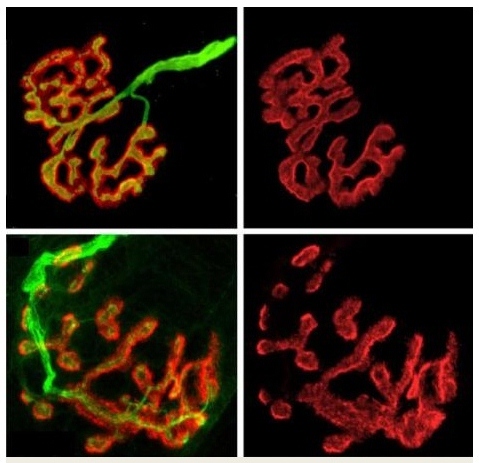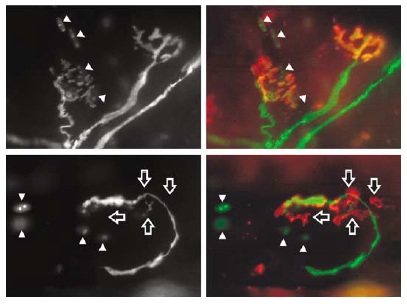Electric slide. Electric signals transmitted through neuromuscular junctions trigger the muscles to move. Video: Takeshi Matsuoka.
With the discovery of nearly 20 genes linked to ALS, researchers are beginning to unravel mechanisms underlying the disease. New drugs are entering the pipeline at a quickening pace. In 2013 alone, at least 10 phase II clinical trials are expected to launch worldwide. And, a phase III clinical trial is anticipated.
Many of these emerging medicines help keep deteriorating motor nerves alive or reduce neuroinflammation. But creating medicines that help keep the muscles and nerves connected has proved especially difficult.
Scientists are now beginning to understand how these so-called neuromuscular junctions are constructed and become rebuilt when the muscles become unplugged due to injury or disease. Some of these molecular ‘architects’ are becoming the basis of emerging medicines for ALS. But there is much work to be done to place these drugs on pharmacy shelves.

Sense and stability. Scientists discovered that biglycan appears to stabilize neuromuscular junctions, the connections between the motor nerves (green) and muscles (red). Image: Courtesy of Justin Fallon, Brown University.
References
Amenta, A.R. et al. (2012) Biglycan is an extracellular MuSK binding protein important for synapse stability. Journal of Neuroscience 32(7), 2324-2334. Abstract | Full Text (Subscription Required)
Williams, A.H., Valdez, G., Moresi, V., Qi, X., McAnally, J., Elliott, J.L., Bassel-Duby, R., Sanes, J.R. and Olson, E.N. (2009) MicroRNA-206 delays ALS progression and promotes regeneration of neuromuscular synapses in mice. Science 326, 1549-1554. Abstract | Full Text (Subscription Required)
Haramati, S. et al. (2010) miRNA malfunction causes spinal motor neuron disease.Proceedings of the National Academy of Sciences 107(29), 13111-13116. Abstract | Full Text
Jokic, N. et al. (2005) Nogo expression in muscle correlates with amyotrophic lateral sclerosis severity. Annals of Neurology 57(4), 553-556. Abstract | Full Text (Subscription Required)
Jokic, N., Gonzalez de Aguilar, J.L., Dimou, L., Lin, S., Fergani, A., Ruegg, M.A., Schwab, M.E., Dupuis, L. and Loeffler, J.P. (2006) The neurite outgrowth inhibitor Nogo-A promotes denervation in an amyotrophic lateral sclerosis model. EMBO Reports 7(11), 1162-1167. Abstract | Full Text
Song, F., Chiang, P., Wang, J., Ravits, J. and Loeb, J.A. (2012) Aberrant neuregulin 1 signaling in amyotrophic lateral sclerosis. Journal of Neuropathology and Experimental Neurology 71(2), 104-115. Abstract | Full Text (Subscription Required)
Ngo ST, Cole RN, Sunn N, Phillips WD, Noakes PG. (2012) Neuregulin-1 Potentiates Agrin-Induced Acetylcholine Receptor Clustering via Muscle Specific Kinase Phosphorylation. Journal of Cell Science, doi: 10.1242/jcs.095109. Abstract | Full Text (Subscription Required)
Learn more about the neuromuscular junctions
Burden, S.J. (2011) SnapShot: Neuromuscular Junction. Cell 144(5), 826-826.e1. Illustration (Subscription Required)
miRNAs decoded. Interfering microRNAs may promote the regeneration of the motor nerves by switching off the synthesis of certain proteins. Video: Nature Publishing Group.

All motor systems NOGO. Scientists found that increased levels of NOGO-A destabilize neuromuscular junctions, the connections between the motor nerves (green) and skeletal muscle (red). Adapted from Jokic, N. et al. (2006), EMBO Reports. Courtesy of Nature Publishing Group. All rights reserved.